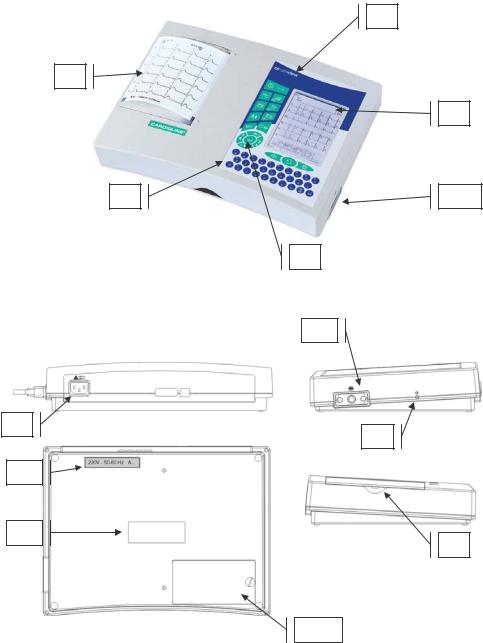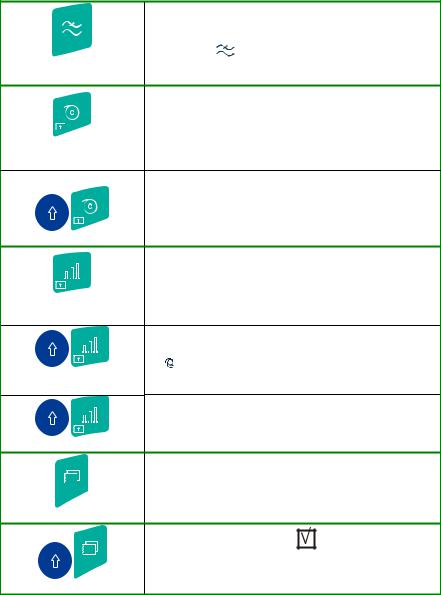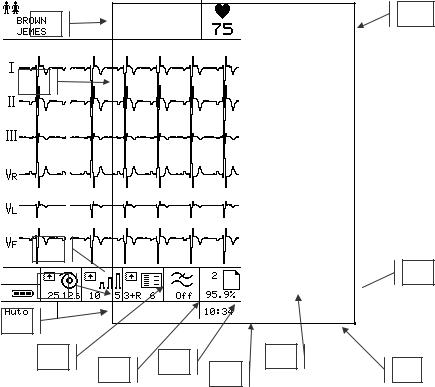Cardioline ar1200view User Manual

ar1200view
User’s Manual
English

This User Manual has been prepared with the objective of giving the user all the necessary information to make the best use of the CARDIOLINE® ar1200view.
General information
et medical devices SpA, continuously in search of technological improvement and customer satisfaction, reserves the right to modify this publication without prior notice at any time.
All rights reserved © et medical devices SpA ITALY.
CARDIOLINE® is a registered trademark of et medical devices SpA
CARDIOLINE® product support services
For any questions about a CARDIOLINE product:
consult the documentation and other printed material included in the package; consult any guidelines available.
If you find no solution, you can obtain further information by contacting your
CARDIOLINE supplier.
Before calling, check you have the available documentation to hand and the product nearby. It may also be necessary to supply the following information:
serial number and product reference number, if available;
type of hardware available, including any network hardware fitted; operating system used, for software products;
exact contents of any error messages displayed;
description of the operation being executed when the problem occurred; description of any action taken to solve the problem.
um_ar1200view_cardioline_01_eng1.doc Rev. 01/sr/GZ 15/09/2005 Ref: 36519130
2

Contents
1 Introduction |
6 |
||||||||||
1.1 |
How to read the manual |
7 |
|||||||||
1.2 |
Information and recommendations relating to safe use |
8 |
|||||||||
1.3 |
The electrocardiograph |
10 |
|||||||||
Front view |
10 |
||||||||||
Side view and bottom |
10 |
||||||||||
Parts, symbols and controls |
11 |
||||||||||
2 Installation and initial preparation |
16 |
||||||||||
2.1 |
Selecting the installation site |
16 |
|||||||||
2.2 |
Loading the thermal paper |
16 |
|||||||||
2.3 |
Power supply; control and management of the rechargeable battery |
17 |
|||||||||
Recharging the battery |
18 |
||||||||||
2.4 |
How to switch on the electrocardiograph |
18 |
|||||||||
2.5 |
How to switch off the electrocardiograph |
19 |
|||||||||
Auto power off |
19 |
||||||||||
3 Preparation for use: the menu |
20 |
||||||||||
3.1 |
How to access the menu |
20 |
|||||||||
3.2 |
Structure of the menu |
20 |
|||||||||
3.3 |
Menu-activated operation and personalization of the electrocardiograph |
23 |
|||||||||
|
|
|
|
|
|
|
|
|
|
||
"Personalize mode" |
|
|
|
|
|
|
|
23 |
|||
|
|
|
|
|
|||||||
|
|
|
|
|
|
|
|
||||
The “ECG archive” |
|
|
|
|
|
|
|
24 |
|||
|
|
|
|
|
|||||||
“Settings” |
24 |
||||||||||
“Tools” |
28 |
||||||||||
4 Preparing for an ECG recording |
29 |
||||||||||
4.1 |
Connecting the patient cable |
29 |
|||||||||
4.2 |
Preparing the patient and applying the electrodes |
29 |
|||||||||
4.3 |
Select recording characteristics operating mode, display and print format, |
||||||||||
speed, sensitivity, filter |
30 |
||||||||||
|
|
|
|
|
|
||||||
Operating mode |
|
|
|
|
30 |
||||||
|
|
|
|
||||||||
Display and print format |
31 |
||||||||||
Speed of recording on the display and on paper |
32 |
||||||||||
Sensitivity of recording on the display and on paper |
32 |
||||||||||
Recording filter |
32 |
||||||||||
3

5 Recording of a rest ECG |
34 |
|||||||||||||||||||||||||||
|
|
|
|
|
|
|
|
|
|
|
|
|
|
|
|
|
|
|
|
|
|
|
|
|
|
|
|
|
5.1 |
Patient data entry |
|
|
|
|
|
|
|
|
|
|
|
|
|
|
|
|
|
|
|
|
|
|
|
|
|
|
34 |
|
|
|
|
|
|
|
|
|
|
|
|
|
|
|
|
|
|
|
|
|
|
|
|
|
|
|||
5.2 |
Recording in manual mode |
35 |
||||||||||||||||||||||||||
5.3 |
Recording in automatic mode |
35 |
||||||||||||||||||||||||||
|
|
|
|
|
|
|
|
|
|
|
|
|
|
|
|
|
|
|
|
|
|
|
|
|
|
|||
Automatic calculation of ECG parameters |
|
|
|
|
|
36 |
||||||||||||||||||||||
|
|
|
|
|
||||||||||||||||||||||||
|
|
|
|
|
|
|
|
|
|
|
|
|
|
|
|
|
|
|
|
|
|
|
|
|||||
Automatic ECG interpretation |
|
|
|
|
|
|
|
|
|
|
|
|
|
|
|
|
|
|
|
|
|
|
|
|
36 |
|||
|
|
|
|
|
|
|
|
|
|
|
|
|
|
|
|
|
|
|
|
|
|
|
|
|||||
|
|
|
|
|
|
|
|
|
|
|
|
|
|
|
|
|
|
|
|
|
|
|||||||
Copy of an automatic ECG recording |
|
|
|
|
|
|
|
|
|
|
|
37 |
||||||||||||||||
|
|
|
|
|
|
|
|
|
|
|
||||||||||||||||||
|
|
|
|
|
|
|
|
|
|
|
|
|
|
|
|
|
|
|
|
|
|
|||||||
ECG memory: saving a recording |
|
|
|
|
|
|
|
|
|
|
|
|
|
|
|
|
|
|
|
|
|
38 |
||||||
|
|
|
|
|
|
|
|
|
|
|
|
|
|
|
|
|
|
|
|
|
||||||||
|
|
|
|
|
|
|
|
|
|
|
|
|
|
|
|
|
|
|
|
|
||||||||
ECG memory: archive management |
|
|
|
|
|
|
|
|
|
|
|
|
|
|
|
|
|
38 |
||||||||||
|
|
|
|
|
|
|
|
|
|
|
|
|
|
|
|
|
||||||||||||
|
|
|
|
|
|
|
|
|
|
|
|
|
|
|
|
|
|
|
|
|
||||||||
Saving to Personal Computer archive |
|
|
|
|
|
|
|
|
|
|
|
39 |
||||||||||||||||
|
|
|
|
|
|
|
|
|
|
|
||||||||||||||||||
|
|
|
|
|
|
|
|
|
|
|
|
|
|
|
|
|
|
|
|
|||||||||
5.4 |
Recording in Emergency mode |
|
|
|
|
|
|
|
|
|
|
|
|
|
|
|
|
|
|
|
|
|
|
40 |
||||
|
|
|
|
|
|
|
|
|
|
|
|
|
|
|
|
|
|
|
|
|
|
|||||||
|
|
|
|
|
|
|
|
|
|
|
|
|
|
|
|
|
||||||||||||
5.5 |
Recording in ECG Autotimer mode |
|
|
|
|
|
|
|
|
|
|
40 |
||||||||||||||||
|
|
|
|
|
|
|
|
|
|
|||||||||||||||||||
|
|
|
|
|
|
|
|
|
|
|
|
|
|
|
|
|||||||||||||
5.6 |
Recording in "paper saving" mode |
|
|
|
|
|
|
|
|
|
|
41 |
||||||||||||||||
|
|
|
|
|
|
|
|
|
|
|||||||||||||||||||
|
|
|
|
|
|
|
|
|
|
|
|
|
|
|
|
|||||||||||||
5.7 |
Recording in ”PC ECG” mode |
|
|
|
|
|
|
|
|
|
|
|
|
|
|
|
|
|
|
|
|
|
|
|
41 |
|||
|
|
|
|
|
|
|
|
|
|
|
|
|
|
|
|
|
|
|
|
|
|
|
||||||
|
|
|
|
|
|
|
|
|
|
|
||||||||||||||||||
5.8 |
Recording in “HRV Analysis" mode |
|
|
|
|
|
|
|
|
|
|
|
|
|
|
|
42 |
|||||||||||
|
|
|
|
|
|
|
|
|
|
|
|
|
|
|
||||||||||||||
|
|
|
|
|
|
|
|
|||||||||||||||||||||
5.9 |
Recording in “Arrhythmia mode” |
|
|
|
|
|
|
|
|
|
|
|
|
|
|
|
|
|
|
|
|
43 |
||||||
|
|
|
|
|
|
|
|
|
|
|
|
|
|
|
|
|
|
|
|
|||||||||
5.10 Defibrillation! |
44 |
|||||||||||||||||||||||||||
6 Management and control of electrocardiograph functions |
45 |
|||||||||||||||||||||||||||
6.1 |
Disconnected electrodes, potential defibrillation |
45 |
||||||||||||||||||||||||||
6.2 |
Batteries low or in need of recharging |
45 |
||||||||||||||||||||||||||
6.3 |
Print system control. Out of paper |
45 |
||||||||||||||||||||||||||
6.4 |
Status messages and error indication: description and related event |
46 |
||||||||||||||||||||||||||
6.5 |
Troubleshooting |
47 |
||||||||||||||||||||||||||
7 Maintenance |
48 |
|||||||||||||||||||||||||||
7.1 |
Self-test |
48 |
||||||||||||||||||||||||||
7.2 |
Replacing the thermal paper |
49 |
||||||||||||||||||||||||||
7.3 |
How to clean the device and the electrodes |
49 |
||||||||||||||||||||||||||
4
7.4 |
Battery replacement |
49 |
7.5 |
Display maintenance |
50 |
7.6 |
Periodic checks |
50 |
Technical information |
50 |
|
8 Technical specifications |
51 |
Basic accessories supplied* |
53 |
5

1 Introduction
ar1200view is an electrocardiograph with dual power supply (mains and rechargeable internal batteries), whose basic configuration allows for the following functions:
ECG recording in automatic, manual, and timed mode;
real-time display of the ECG signal on the built-in graphic display in 3, 6 channel format;
reproduction of the ECG signal on several different formats of 120mm paper by means of the high resolution thermal printer: 3, 3+R, and 6 channels;
sorting of the tests according to clock, dater and alphanumeric keyboard to manage user and patient data;
storage of the most recent automatic recording and print of additional copies;
setting of up to 4 different user profiles to tailor device functions to differing requirements.
ar1200viewv can be updated with:
•“memory option”: storage of up to 40 full ECG exams, with no need to print out immediately on paper (“paper saving” mode);
•"ECG parameters option": automatic ECG parameter measurement program;
•"ECG signal interpretive option": a useful and dependable diagnostic support;
•"arrhythmia option": a program enabling detection of arrhythmia events during continuous recording;
•“HRV analysis option”: a program enabling detection of variations in heart rate;
•“PC archive option": for saving the exam to archive stored in a personal computer running CARDIOLINE software. The data upload to the PC is made by use of the wireless “IR” interface; no direct connection to the PC is required.
•“PC-ECG option": for real time display of the twelve leads on your computer screen to allow management of patient medical records and archiving of exams in digital format using CARDIOLINE software. The software has an optional module for automatic interpretation of the ECG signal.
•“Emergency option”: allows to perform and eventually transmit, an ECG exam taken in emergency situation in completely automatic mode.
For more information on available options, contact your selected dealer.
6

THANK YOU FOR BUYING CARDIOLINE!. Your new computerised electrocardiograph CARDIOLINE® has been designed and built in compliance with the applicable regulations in force at the time when et medical devices SpA, Cavareno (Trento) - ITALY drew up this manual. et medical devices operates in accordance with the requirements for quality management systems defined by EN ISO 9001: 2000 and EN ISO 13485: 2003 standards. The system is covered by a Nemko Certification AS (Cert. N. 800278). Your new electrocardiograph has also been built in compliance with the Medical Device Directive 93/42/EEC and is therefore marked by the relevant CE0470 mark.
1.1 How to read the manual
In order to ensure the CARDIOLINE® ar1200view is operated in a safe and correct manner, and to appreciate its ease of use and high reliability, the user instructions must be read carefully.
This documentation describes the functions of your electrocardiograph including those provided by all the possible "options" available. It is therefore possible that some of the functions described may not be present in the model you have purchased. For details of the options, consult the "firmware configuration" chart that accompanies each individual appliance.


 This symbol allows you to identify the functions not provided on all models, which must be requested specifically at the time of purchase.
This symbol allows you to identify the functions not provided on all models, which must be requested specifically at the time of purchase.


 This symbol allows you to identify the functional, behavioural and operational aspects that may be conditioned by the type of configuration selected during the step of “Preparation for use: the menu”.
This symbol allows you to identify the functional, behavioural and operational aspects that may be conditioned by the type of configuration selected during the step of “Preparation for use: the menu”.
SMB
 When a given key is depicted in the body of a sentence or a paragraph, press the corresponding key on the device to perform the action.
When a given key is depicted in the body of a sentence or a paragraph, press the corresponding key on the device to perform the action.
The structure of this manual allows you to approach the use of the electrocardiograph according to your level of knowledge. If you have already had experience with CARDIOLINE® equipment, the initial fast-track part of each paragraph will allow you to begin working immediately. In the continuation of the paragraph, on the other hand, the single aspects of operation are discussed in more depth.
The manual gives detailed information on the use of the model ar1200view in traditional ECG procedures, and an introduction to the use of particular functionalities involving interaction with software and a Personal Computer. For instructions on the use of the software applications for Personal Computer, consult the special online guides.
The quick guide to the electrocardiograph (at power-up the display shows
7

|
1 |
|
the message “ ? Press 1 ”: |
Q |
to obtain the printout) sums up the |
|
operations linked to the single commands presented in the manual.
Further information and clarifications can be requested directly from:
CARDIOLINE® - Supporto Prodotto
Strada Rivoltana Nuova, 53, I - 20060 Vignate (MI) ITALIA e-mail: et.service@etmed.biz
tel. +39 02 95 05 181 fax: +39 02 95 66 013
1.2Information and recommendations relating to safe use
-The electrical system used by the device must be in accordance with the standard in force.
-Always use the equipment according to the instructions in this manual.
-The device is equipped with a set of standard accessories. For reasons of safety, reliability and conformity with the Medical Devices Directive 93/42/EEC, use only original accessories or accessories approved by the manufacturer.
-The device is equipped with a special long-life thermal head writing system, which allows maximum writing precision. To avoid frequent and costly replacements and repairs, always use the original paper or paper approved by the manufacturer. The manufacturer will not accept liability for any damage to the device or any other adverse effect caused by the use of unsuitable paper.
-Do not subject the device to impact or excessive vibrations.
-Do not allow liquids to penetrate inside the device. If this should accidentally occur, have the device tested by an Authorised Assistance Centre to verify its functional efficiency, before using it again.
-Make sure that the value of the supply voltage corresponds to that indicated on the data plate of the device.
-If you are using the device in connection with others, ensure that: all connections are made by skilled persons; all connections comply with safety regulations; all other devices connected respond likewise to regulations. Non-compliance with regulations can cause physical harm to the patient connected and to the person operating the device. Should it be difficult to obtain the necessary information for assessing the risk of the individual connections, apply directly to the manufacturers concerned or avoid making the connections.
-In the event of other equipment being connected directly or indirectly to the patient, check for the possible risks caused by the sum of the leakage currents on the body of the patient.
-The device is protected against defibrillation discharges in accordance with IEC standard 601-1-25; to ensure that the signal is restored, use
8
only original electrodes or electrodes responding to IEC and AAMI standards.
-If an electrosurgical scalpel is in use, the patient cable should be disconnected from the device.
-At all events, when defibrillators or high-frequency surgical devices are being used at the same time, it is essential to take the greatest care. If there is any doubt when such devices are in use, disconnect the patient from the electrocardiograph temporarily.
-The device recognises the impulses generated by a pacemaker and does not interfere with its operation, as prescribed by standards in use at the time of drafting this manual.
-Avoid exposing the equipment to extreme temperatures, excessive dust or dirt, and very salty or damp environments; observe the ambient conditions described in detail under the "Technical specifications” heading.
-Periodically check the efficiency of all accessories and of the device itself. Contact the Authorised Assistance Centre whenever the device seems to be operating irregularly. To prolong the life of your device, have it checked periodically by an Authorised Assistance Centre.
-Warning: The electrocardiograph can be used for intracardial applications.
-Warning: It is therefore necessary, before activating the equipment, to make sure of the connection to ground (normally secured by the power supply cable). If grounding of the main electrical service is not certain, do not connect the device and use it powered only by the rechargeable internal battery.
-Warning: do not use the device in the presence of anaesthetics or volatile gases!
-Warning: devices for medical applications must be used only by persons who by virtue of training or practical experience are able to ensure maximum safety and effectiveness in operation. Operators must in any event read this manual carefully and familiarise themselves with the instrument before using it on a patient.
-Warning: the indications obtained using automatic interpreting programs or other diagnostic aids must be reviewed and countersigned by a qualified medical person!
-Warning: the device is provided with an IR interface for the transfer of data to other devices. The IR interface must not be masked, even accidentally, as this will adversely affect its capability and its operation, interrupting and preventing the correct flow of data.
-The manufacturer will acknowledge liability for the safety, reliability and functional efficiency of the device only if:
modifications and repairs are performed by the manufacturer or by an Authorised Assistance Centre;
the AC mains power supply of the building responds to current regulations;
the device is operated according to user instructions;
any accessories in use are those approved by the manufacturer.
9

1.3 The electrocardiograph
Front view
1
6
2
4 |
5 |
3
Side view and bottom
5
8
7
10
9
6
11
10

Parts, symbols and controls
2.Keyboard:
Function |
|
|
|
Messages & Symbols displayed / |
|||
key |
|
|
|
|
Associated LED |
||
|
|
|
|
|
|
- |
LED on: device connected to |
|
|
|
|
|
|
|
mains power; internal battery |
|
|
|
|
|
|
|
charging |
|
|
|
|
|
|
- |
“full” symbol: battery charged |
|
|
|
|
|
|
- |
“part empty” symbol battery |
|
|
|
|
|
|
|
power less than 30% |
on/ off |
|
|
|
|
|
- |
“empty” symbol: internal battery |
|
|
|
|
|
|
|
flat; the device must be |
|
|
|
|
|
|
|
connected to the mains power |
|
|
|
|
|
|
|
for recharging |
|
|
|
|
|
|
- |
Indicated electrodes not |
select start operating |
|
|
|
|
|
|
connected or insufficient |
|
|
|
|
|
|
contact; saturation |
|
mode |
|
|
|
|
|
|
|
interrupt current |
|
|
|
|
|
|
|
operation; stop |
|
|
|
|
|
|
|
|
|
|
|
Auto |
- |
Automatic recording |
|
|
|
|
|
|
|
|
|
|
|
|
|
Man |
- |
Manual recording |
|
Select operating mode |
|
Personalized |
- |
Recording mode selected in |
|||
|
|
configuration phase |
|||||
|
|
|
|
|
|
|
(“Personalize mode”) |
|
|
Automatic mode: |
|
|
|||
|
|
available formats |
- |
In manual mode, print and |
|||
|
- |
3, 6 |
|
|
|||
|
|
|
|
display format selections are |
|||
|
|
Manual mode: |
|
||||
|
|
|
consistent with each other |
||||
Select ECG display |
|
available formats |
|
||||
|
|
|
|||||
format |
- |
3, 6 |
|
|
|
|
|
|
|
|
|
|
|||
|
|
Automatic mode: |
|
|
|||
|
|
available formats |
|
|
|||
|
- |
3, 3+R, 6 |
- |
In manual mode, print and |
|||
|
|
Manual mode: |
|
display format selections are |
|||
|
|
|
consistent with each other |
||||
|
|
available formats |
|
||||
Select print format |
|
|
|
||||
|
3, 6, |
|
|
|
|||
|
|
|
|
|
|||
|
|
|
|
|
|
|
|
11

On display: On / Off
- Filter on
On paper:
AC mains and muscle interference filter
Available speeds: 12.5
– 25 – 50 mm/s
Select ECG scroll speed on display
Available speeds: 5, 25, 50 mm/s
Select paper scroll speed
|
|
Available |
|
Select ECG recording |
wavelengths: 5, 10, 20, |
|
|
|
|
|
|
sensitivity on screen |
|
|
|
|
Available wavelengths 5, 10, |
|
|
Select ECG recording |
20, |
Automatic |
|
|
|
|
|
sensitivity on paper |
|
|
|
|
|
- |
Displays patient data file |
Enter patient data |
|
|
|
Copy last recording |
|
|
|
|
|
- |
|
Store in PC |
|
|
|
12

2.Display: to display the ECG signal, control operations, patient data, report data and settings.
d
a
b
o
 i m
i m 
c
e |
g |
|
h |
|
f |
n |
l |
||
|
||||
|
|
|
In normal operating mode:
a.Patient data area: displays Last Name (first line) and First Name (second line).
b.ECG signal display area Each lead is preceded by its name
c.Selected operating mode. In Menu mode, ▲▼◄► indicates scroll functions enabled.
d.Heart rate.
e.Selected speed of printing (value on left) and display (value on right)
f.Selected sensitivity of printing (value on left) and display (value on right)
g.Selected print format (value on left) and display format (value on right)
13

h.Filter in place/not in place indicator.
i.Number of tests stored and space available  , in Autotimer, HRV
, in Autotimer, HRV


 and Arrhythmia mode
and Arrhythmia mode 

 , it displays test timing.
, it displays test timing.
l.Time display.
m.Battery status indicator
n.Operating information and error message area. In Menu mode, it indicates enabled keys and any additional options.
o.In Autotimer, HRV, PC-ECG, Store in PC modes, Arrhythmia displays a progress bar.
3.Display control keyboard.
c s E
Cancel operation, back to previous menu.
scroll menu and information. In main
screen, |
scroll leads on display |
Access to Menu. It scrolls multiple selections, if any, symbol  displayed.
displayed.
4. Alphanumeric keyboard for patient data management.
Characters that can be displayed in sequence are associated to each key.
Deletes texts before cursor.
 Confirms operation.
Confirms operation.
14

5.Patient cable connector.
6.Paper compartment door.
7.Reset button  : used to re-establish normal operating conditions in the event of an error that cannot be managed using the keyboard.
: used to re-establish normal operating conditions in the event of an error that cannot be managed using the keyboard.
8.“Mains line” connector.
9.Identification plate. Please, refer to the information shown on this plate during any communication with the Authorised Support Centres.
10.Rated voltage plate.
11.Rechargeable battery compartment door.
15

2 Installation and initial preparation
This section describes the operations to be performed before using your new CARDIOLINE® ar1200view electrocardiograph. Suggestions are given for "selecting the installation site" and "recommendations for safe use in conformity with current statutory regulations" are indicated. Also introduced are the operations involved in preparing the electrocardiograph for use, such as "loading the thermal paper", "power supply”; “control and management of the rechargeable internal battery", "switching on and off", "the menu", "set-up".
2.1 Selecting the installation site
Your electrocardiograph complies with European directives on electromagnetic compatibility. The absence of emissions damaging to radio and telecommunications transmissions is therefore assured, as also is protection from interference emitted by other systems and equipment Nevertheless, in order to protect your device from other equipments not in conformity with the aforementioned directives:
-avoid the use of mobile phones near the electrocardiograph;
-place the electrocardiograph as far as possible from electrical power lines and sources of static electricity. The ECG signal can be disturbed if the electrocardiograph is placed near sources of high voltage or electricity lines;
-avoid placing the electrocardiograph close to other diagnostic or therapeutic equipment (e.g. X-ray machines, ultrasound machines, electrically operated beds, etc.) that could be a source of excessive interference and ECG signal distortion;
-if it is impossible to position the electrocardiograph at a distance from other electrical equipment, switch the other equipment off while recording an ECG.
Also, to avoid the effect of ambient conditions when recording ECG:
-record in a room where the temperature is between 20 and 25 degrees Centigrade. This precaution prevents the patient from feeling cold, which could increase shivering and contribute to muscle tremor;
-record using the battery, disconnecting the device from the mains power supply. This avoids presence of mains power disturbance of the recorded ECG signal.
2.2 Loading the thermal paper
CARDIOLINE® ar1200view is able to reproduce the ECG signal both on thermal paper in rolls and on thermal paper in packs. No particular configuration procedure is required. To correctly load the two types of paper:
16

If using paper in rolls:
a.Open the paper compartment using a coin or a similar object, remove the “roll guide” hub and the “pack guide”. To avoid losing the “guide”, place it in a safe place. If replacing an empty roll, retrieve the core before throwing away the empty roll.
b.Insert the hub in a new paper roll (1) and house it in the paper compartment by positioning the pins in their specific guides (2). Make sure that the black mark on the paper is in the upper part of the roll.
c.Position the paper by centring it between the two paper-guides (3). Close the cover with the paper positioned between the rubber roller and the device case (4).
If using paper in packs:
a.Open the paper compartment using a coin or a similar object, remove the “pack guide” and the “roll guide” hub. To avoid losing the “guide”, place it in a safe place.
b.Prepare a new pack (1) and house it in the paper compartment. Make sure that the red mark on the paper is on the upper left part of the pack.
c.Position the paper guide plate (2) onto the pack.
d.Position the paper exactly in the centre between the two paper-guides
(3). Close the cover with the paper positioned between the rubber roller and the device case (4).
Warning: For reasons of safety the device must be used only with the paper compartment cover duly closed.
Warning: use only original thermal paper or paper approved by the manufacturer. The use of paper that does not respond to the manufacturer's specifications could jeopardise the correct operation of the device.
2.3Power supply; control and management of the rechargeable battery
Your electrocardiograph uses a dual power supply system: AC supply mains and rechargeable NiMh battery.
The rechargeable battery, which consists in a pack with 5+5 elements, is housed in the special-purpose compartment located at the sliding bottom of the device, and is protected against short circuits.
Warning: before using the device, it is necessary to go through a complete cycle of recharging of the battery!
Before connecting the electrocardiograph to the AC supply with the cable supplied, make sure that the device supply voltage and the mains voltage are the same.
17
